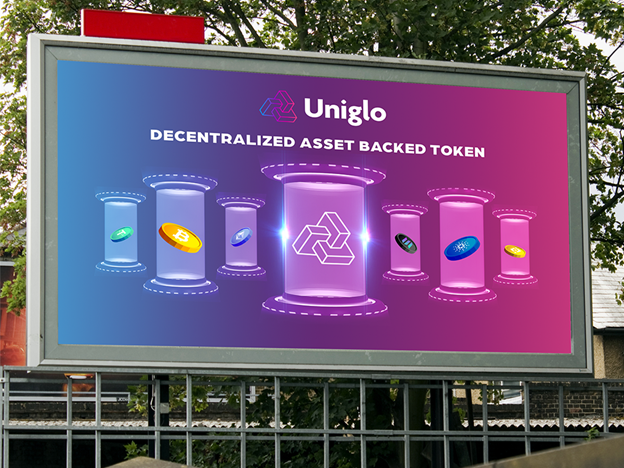Cryptocurrency came to the market with the hope of offering exchanges that did not require a centralized body overseeing transactions. While crypto has been successful in introducing decentralized solutions to the public, may coins like Bitcoin (BTC), Ethereum (ETH), and Cardano (ADA) remain volatile. And in the bear market, this volatility has been a big problem.
So, a newcomer to the space–Uniglo (GLO)–aims to counter that volatility by implementing fractionalized ownership of a range of assets that can combine high growth with risk mitigation.
Uniglo (GLO)
Uniglo is a new cryptocurrency project that will hold a special asset vault. It starts with a small treasury funded through the collection of 5% of a buy-and-sell tax. As the treasury grows, the community will purchase a range of assets including cryptocurrencies, NFTs, real-world collectibles, and digitized gold. The Uniglo vault assets play an important part in backing the floor price of the Uniglo token.
Gold is one of the oldest and most reliable assets in the world. And thanks to protocols like Paxos, people can now invest in gold digitally–this takes the form of digitized gold which is backed by physical gold. So when Uniglo invests in it, investors would own digitized fractionalized gold assets. Through fractional investing, GLO token holders can penetrate the gold market through a low cost and low risk manner.
Bitcoin (BTC)
With Bitcoin, fractionalized asset ownership means little. An investor holds his or her Bitcoin and enjoys the gains in its price—and that’s about it. Historically, the gains of Bitcoin have been astronomical. Hence, BTC remains an attractive coin to hold, and it is still the crypto leader. However, as new tokens enter the market, introducing novel approaches to investment gains and use cases, Bitcoin could one day lose its status as the crypto king.
Ethereum (ETH)
Ethereum is the second placer in the crypto market and closest competition of Bitcoin. As an asset, the Ethereum token is also volatile. On the bright side, Ethereum has a form of participation in fractionalized asset ownership–it supports NFTs that are now being fractionalized to be more accessible to the public. However, the NFT arena on Ethereum remains speculative. It has a long way to go before it could be considered as a source of stable assets. Moreover, fractionalizing NFTs requires power usage, which is known to get costly on Ethereum.
Cardano (ADA)
Cardano has been expanding the uses cases for its token ADA. A Cardano offering that is quickly becoming popular is its NFT-backed loan. Developers in the community have worked hard on an NFT-DeFi bridge to introduce improvements to the platform’s loan services. Similar to Ethereum, Cardano has many protocols for fractionalizing NFTs. Unfortunately, however, Cardano’s token has also been affected by Bitcoin price fluctuations.
The bottom line
With rising costs and a struggling economy, fractionalized assets could play an important part in the future of cryptocurrency investment and ownership. By purchasing the Uniglo token now, investors would be a step closer towards having a fractionalized holding of the Uniglo Asset Vault.
For More information:
Join Presale: https://presale.uniglo.io/register
Website: https://uniglo.io
Telegram: https://t.me/GloFoundation
Discord: https://discord.gg/a38KRnjQvW
Twitter: https://twitter.com/GloFoundation1
Disclaimer: This is a paid release. The statements, views and opinions expressed in this column are solely those of the content provider and do not necessarily represent those of Bitcoinist. Bitcoinist does not guarantee the accuracy or timeliness of information available in such content. Do your research and invest at your own risk.
